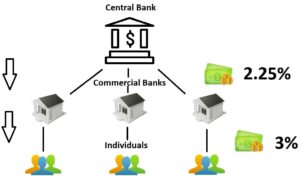The foreign exchange market, also known as forex, is a dynamic and exciting arena for traders. However, its very nature presents inherent risks alongside the potential for significant rewards. This is where the concept of the risk-reward ratio (RRR) comes into play. By understanding and effectively utilizing RRR, forex traders can significantly improve their strategies and achieve long-term success.
Demystifying the Risk-Reward Ratio
The RRR is a fundamental metric that compares the potential profit of a trade to the potential loss. It essentially helps traders gauge the risk they are taking for a given reward. Here’s how it’s calculated:
RRR = (Take Profit Target – Entry Price) / (Entry Price – Stop Loss Level)
Let’s break down the components:
- Take Profit Target: This is the price at which a trader aims to close their position for a profit.
- Entry Price: This is the price at which a trader opens their position.
- Stop Loss Level: This is a predetermined price level at which a trader automatically exits a losing position to minimize potential losses.
For example, imagine a trader enters a long position (buying) on the EUR/USD pair at 1.1000. They set a take profit target at 1.1100 and a stop loss at 1.0900. Using the formula:
RRR = (1.1100 – 1.1000) / (1.1000 – 1.0900) = 1:1
In this case, the RRR is 1:1, indicating that the potential profit is equal to the potential loss.
Why is RRR Important in Forex Trading?
There are several compelling reasons why RRR is a cornerstone of successful forex trading:
- Promotes Discipline: By consciously calculating the RRR before entering a trade, forex traders are forced to consider potential risks alongside potential rewards. This encourages a more disciplined and calculated approach.
- Improves Risk Management: RRR serves as a vital tool for risk management. By aiming for a higher RRR, traders prioritize minimizing potential losses while aiming for larger profits. This helps ensure long-term sustainability in the market.
- Provides a Benchmark for Trade Evaluation: Forex traders can use RRR to compare different trade opportunities and identify setups with a more favorable risk-reward profile. This ensures they are allocating capital to trades with the highest potential for success.
- Helps Manage Winning and Losing Streaks: Even the most skilled traders experience winning and losing streaks. A strong focus on RRR can help mitigate the impact of losing trades. As long as winning trades have a higher RRR, overall profitability can still be achieved.
Optimizing Your Forex Strategy with RRR
Now that we understand the significance of RRR, let’s explore how forex traders can leverage it to optimize their strategies:
- Setting Ideal RRR Levels: While there’s no single “ideal” RRR, most successful traders aim for ratios greater than 1:1. This means aiming to earn more than you risk on each trade. A common target is a 2:1 RRR, signifying a potential profit twice the amount risked.
- Identifying High Probability Setups: Not all trades are created equal. Skilled traders use technical and fundamental analysis to identify high probability setups with a strong potential for success. Focusing on these setups allows them to justify a lower winning percentage as long as the RRR remains favorable.
- Stop-Loss and Take-Profit Orders: Stop-loss orders are crucial for managing risk and directly influence your RRR. Placing them strategically ensures you exit losing trades before significant losses occur. Conversely, take-profit orders lock in gains when the price reaches your target.
- Position Sizing: Position sizing refers to the amount of capital allocated to each trade. By considering your RRR and risk tolerance, you can determine an appropriate position size. For riskier trades with a lower RRR, a smaller position size is advisable.
- Adapting to Market Conditions: Forex market conditions are constantly evolving. A sound strategy incorporates the flexibility to adjust RRR targets based on market volatility. During volatile periods, a more conservative RRR (closer to 1:1) might be prudent.
- Backtesting and Refinement: Backtesting involves testing your trading strategy on historical data. By incorporating RRR into your backtesting process, you can assess the effectiveness of your strategy and refine it to achieve a more favorable risk-reward profile.
Beyond the Basics: Advanced RRR Techniques
- Trailing Stop-Loss Orders: A trailing stop-loss is a dynamic order that automatically adjusts as the price moves in your favor. This helps lock in profits while allowing you to potentially capture even larger gains. However, it’s crucial to set the trailing parameters wisely to avoid premature exits.
- Asymmetric Risk-Reward: This approach acknowledges that not all winning and losing trades will have the same size. It allows for a higher potential reward than the potential loss, even if the win rate is lower. This strategy can be particularly useful for exploiting strong trends.
- Monte Carlo Simulations: This advanced technique utilizes computer simulations to model various market scenarios and assess the potential impact on your RRR. While complex, it can provide valuable insights for experienced traders looking to further optimize their risk management strategies.
The Psychology of RRR
While RRR is a mathematical concept, its effectiveness hinges on a trader’s psychology. Here are some psychological aspects to consider:
- Emotional Control: The forex market can be emotionally charged, especially during losing streaks. A strong focus on RRR helps traders stay disciplined and avoid making impulsive decisions based on fear or greed.
- Patience: Waiting for the right trade setups with a favorable RRR can be challenging. However, patience is crucial for long-term success. Don’t be tempted to force trades that lack a compelling risk-reward profile.
- Learning from Losses: Every trade, win or lose, offers valuable lessons. Analyze losing trades to understand why the RRR wasn’t met and use those insights to refine your strategy for future trades.
The risk-reward ratio is a powerful tool that empowers forex traders to make informed decisions, manage risk effectively, and optimize their strategies for long-term success. By understanding the core principles, implementing advanced techniques, and maintaining a sound psychological approach, traders can navigate the dynamic forex market with greater confidence and achieve their financial goals.
Remember: Forex trading involves inherent risks, and past performance is not necessarily indicative of future results. Always conduct thorough research, understand your risk tolerance, and never invest more than you can afford to lose.
Let’s Manage Your Forex Funds With Fx Pips Guru!
Fx Pips Guru is a forex fund management company managing client’s funds based on monthly profit share. Let’s do Live Chat with our experts.




